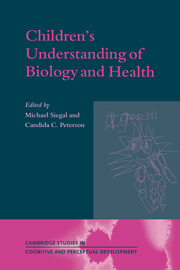Book contents
- Frontmatter
- Contents
- List of contributors
- Preface
- 1 Becoming mindful of biology and health: an introduction
- Part I Development of biological understanding
- 2 Children's understanding of mind–body relationships
- 3 How a naive theory of biology is acquired
- 4 Constructing a coherent theory: children's biological understanding of life and death
- Part II Health issues
- Part III Applications
- Appendix: Hypothetical dilemma vignettes
- Author index
- Subject index
3 - How a naive theory of biology is acquired
Published online by Cambridge University Press: 06 July 2010
- Frontmatter
- Contents
- List of contributors
- Preface
- 1 Becoming mindful of biology and health: an introduction
- Part I Development of biological understanding
- 2 Children's understanding of mind–body relationships
- 3 How a naive theory of biology is acquired
- 4 Constructing a coherent theory: children's biological understanding of life and death
- Part II Health issues
- Part III Applications
- Appendix: Hypothetical dilemma vignettes
- Author index
- Subject index
Summary
Two of the most important questions we can ask about theory change are what happens, and what makes it happen. The descriptive question is comparatively easy, and has given rise to numerous studies comparing children with varying degrees of biological knowledge – as can be seen in this volume, and in reviews by Carey (1985), Wellman and Gelman (1992, 1997), and others. Perhaps because the explanatory question is more difficult, there have been relatively few detailed suggestions as to what drives changes in an early theory of biology, and about how such a theory emerges in the first place.
Existing proposals about the acquisition of a framework theory of biology can be divided into two types. Type 1 proposals link the emergence of a theory of biology to innate predispositions. In particular, it has been suggested that naive essentialism, and a teleological stance, contribute to the acquisition of a naive biology, by constraining the type of input that children notice and the way they put the input to use (e.g., Gelman and Hirschfeld, 1990; Keil, 1992; Kelemen, 1998). In each case there is some debate over the extent to which the predisposition is domain-specific, but most Type 1 proposals reflect the assumption that a theory of biology is an early, autonomous competency rather than an offshoot of some other theory.
Type 2 proposals are based on the assumption that a naive theory of biology is originally not fully distinct from other framework theories, in particular a naive psychology (e.g., Carey, 1985), or, according to one recent proposal, a naive mechanics (Au and Romo, 1999).
- Type
- Chapter
- Information
- Children's Understanding of Biology and Health , pp. 45 - 70Publisher: Cambridge University PressPrint publication year: 1999
- 25
- Cited by



